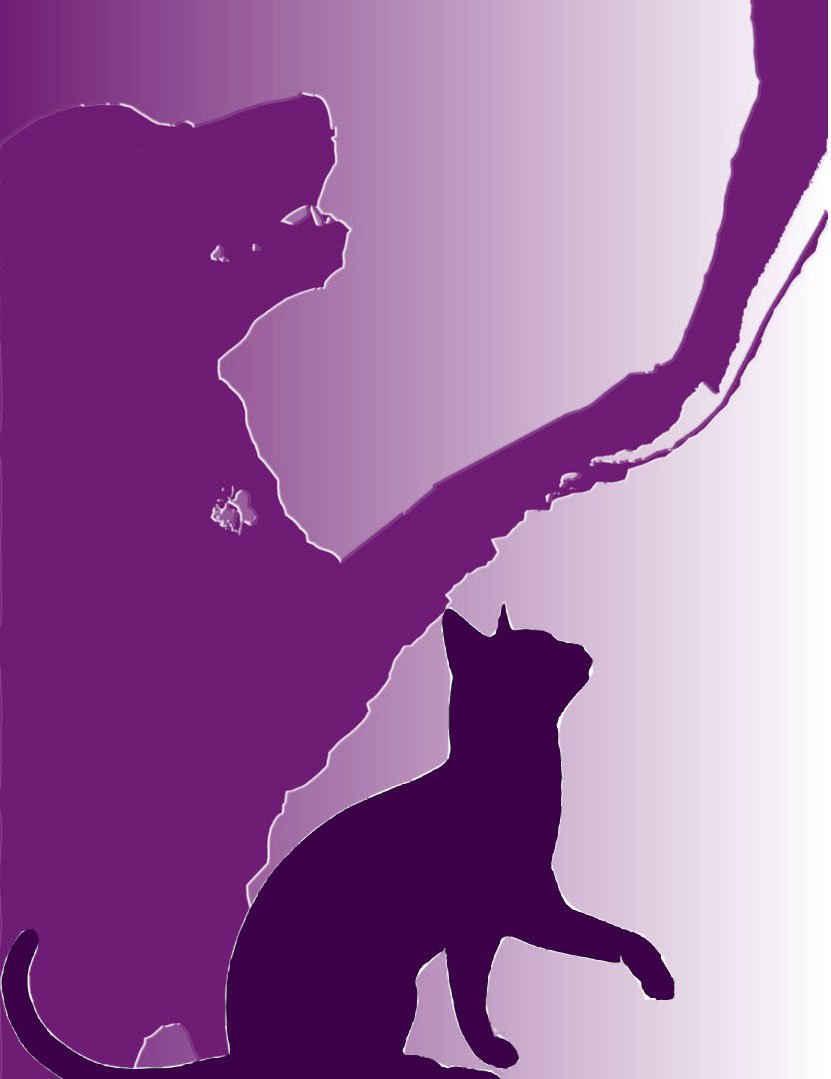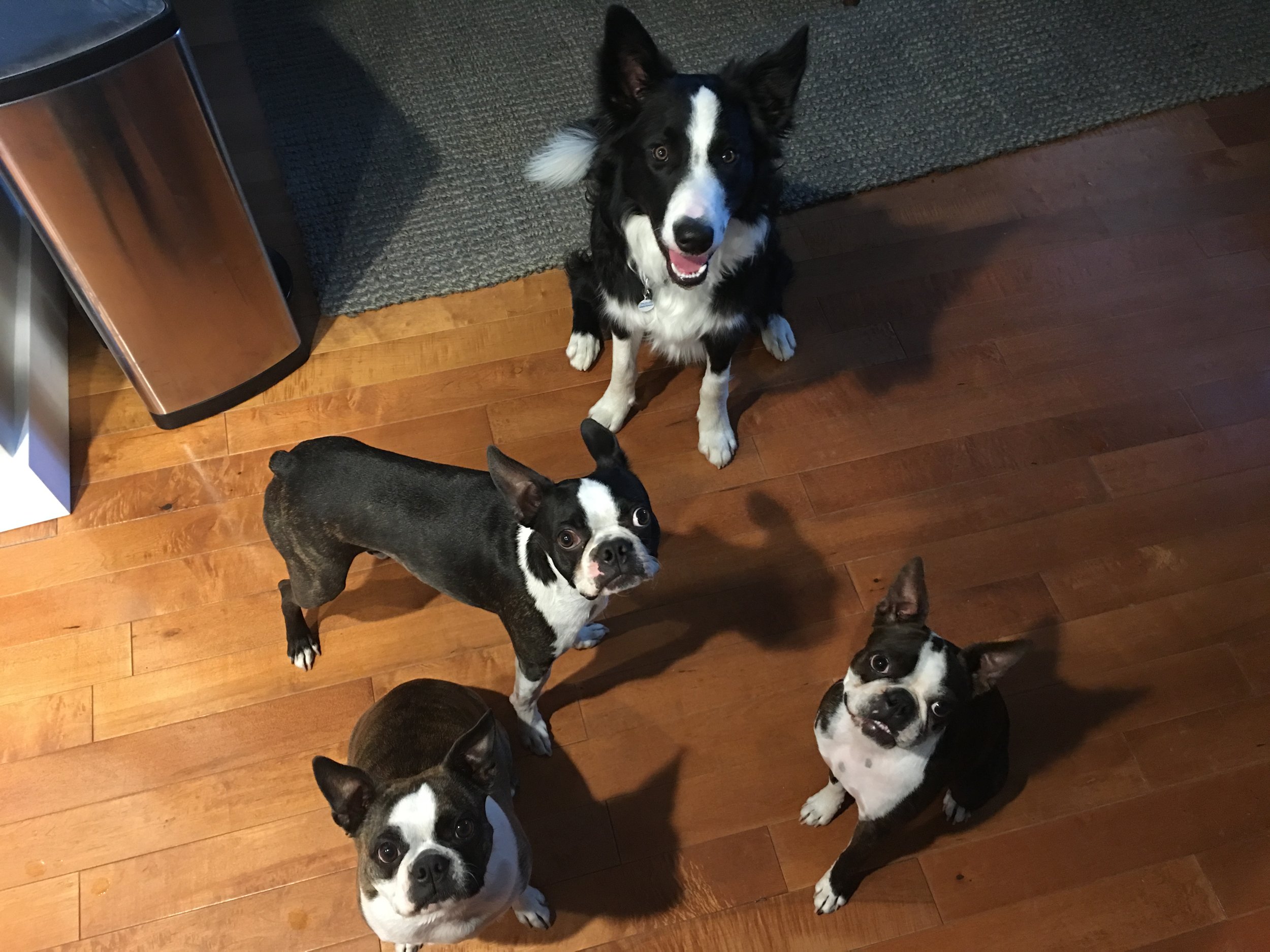Multi-dog household conflicts
Jamie Flanders CDBC, CFDM, FPPE, CBC
Living in a PHRAT house
Are you dog-wise?
PHRAT, this Acronym covers factors that lead to an increased probability of conflict between a group of dogs. Understanding all the PHRAT possibilities that exist in your home and everyday life with your dogs will help you to create protocols and strategies to help the dogs avoid tension, conflicts, and fights. When you live with more than one dog there is always a possibility of tension, conflicts, or even fights arising. Much of the time dogs can work it out without harming each other by using body language to communicate their feelings, but sometimes they can’t work it out and tension, conflicts, or fights occur. When I say “fight”, I mean physical contact, sparring, fast/frenzied movements, ears flattened, canine teeth showing, stiff bodies, tails high and stiff, biting with or without pressure, snarls, growls, growl-barks, and it’s difficult to interrupt…. when I say tension or conflict, I mean ritualized calming or stress signals are being used back and forth between them, stiffness in their body, slow careful and deliberate movements, usually no physical contact and easier to interrupt and redirect. There are many factors that can influence your dog’s behavior, as well as their relationships with each other and put them at risk for tension, conflicts, or fights. Do you know what they are?
Proximity. Dogs have a personal space bubble just like people do. Some dogs do not feel comfortable in tight or enclosed spaces with other dogs, people, or children. This can become an issue in hallways, rooms crowded with furniture or clutter, and at thresholds such as doorways and gates.
Health. Both physical factors like pain, discomfort, and diet, and mental factors such as stressors (including unmet enrichment needs, excessive confinement, or a chaotic environment disrupting rest) significantly impact behavior. Addressing these health aspects should be a primary step when tackling any behavioral concerns in pets.
Resources such as, toys, space, your attention, access to furniture, food, bones, access to important areas like the dog door or preferred resting spots, and anything new such as new toys, new furniture, or new amazon packages. Resource guarding is not something that you can get rid of, it is a hard-wired behavior in living things. Protecting valued resources is necessary for survival.
Arousal. Arousal in dogs refers to a state of heightened physiological and psychological alertness and responsiveness to stimuli. It's not inherently good or bad, but rather a natural state that can be triggered by various factors, both positive and negative. Think of it as the dog's "volume" being turned up. Some examples of arousing situations could be, you coming home after a long absence, guests knocking on the door, children screaming and rough housing, humans hugging, play, or fence fighting with neighbor dogs.
Thresholds. In this case I am referring to physical thresholds such as doorways, gates, or car doors. The order of which dog gets there and goes through first (resource) and if they are moving through the threshold at the same time (proximity) can impact their behavior at thresholds.
When your dogs are having tension, conflicts or fights, it is crucial that you become more dog-wise and understand how PHRAT can effect behavior and relationships between dogs and between dogs and humans.
Dog-wise tips:
Understand PHRAT!
Become aware of body language – A lot of the communication dogs use will go unnoticed by us because it’s subtle and context based such as becoming still, hard staring, blocking entry ways, splitting, physical pressure, eye avoidance, head turns, ground sniffing, muzzle feinting, tongue flick, yawning, exposing the front teeth, exposing the canine teeth. It’s typically the escalation of these signals that catches the untrained eye, such as hackles up, snarling, growling, air snapping, and fighting. You will need to notice the subtle signals and intervene at that time, you do not want to wait until the dogs begin to escalate. Once there is escalation the situation becomes harder to control.
Choose your structure and training efforts wisely - What I mean by structure is setting up the environment and antecedent arrangements in such a way that it sets your dogs up for success. For example, say you have an issue where if dog A goes through a doorway first, he will turn and block or bully dog B as she tries coming through the doorway (the T and R in PHRAT). In this case, you maybe able to easily solve the problem by structuring it so that both dogs have to wait until released by name to go through the door (a trained skill) and ensuring that you release dog B first (antecedent arrangement). Canine relationship dynamics are complicated, even the most skilled dogs can have tension, conflicts, or fights between them. Building more skills in your dog can be a useful and necessary part of the treatment plan, but the variables under PHRAT are not going to be resolved through training (or more obedience) alone and if applied inappropriately can do nothing to help solve the problem or may exacerbate the problem, in that it could potentially mix stress and frustration into the equation.
Resist the urge to try to establish an artificial pecking order – Resource guarding is the one area in living with a dog where the term dominance is used correctly. Dominance is a fluid relationship. Which means that one dog may be dominant over one thing but not another. Individual dogs value different things and will or will not defer to each other depending on who they are interacting with depending on what other PHRAT variables are present. Tension, conflicts, or fights over resources are not something you can solve by trying to control whose top dog and who isn’t. It doesn’t matter what your status is in life, King or peasant, you value what you value.
Resist the urge to punish – Seeing your pets fight is an emotional event. Getting angry and punishing is not going to solve the problem and may aid in making it worse. There is a fundamental relationship issue at play, if you try punishment you run the risk of creating negative associations between the dogs, you do not want to make any of the dogs more threatening to each other than they already are.
Embrace management solutions – Any good treatment plan will include management solutions. Management helps to avoid allowing your dogs to rehearse the unwanted behaviors while you’re working on the treatment plan. Management solutions come in many forms like physical barriers, rearranging routines, or crate and rotate. Sometimes the management solutions are permanent, sometimes they are temporary, and a lot of the time they are inconvenient. Every time your dog rehearses the unwanted behavior it becomes more and more ingrained and harder and harder to solve. No matter how hard you work on your treatment plan strategies and training, you will not make any progress if you haven’t made it impossible for your dogs to rehearse the unwanted behavior.
So are you ready to learn how to implement all of this and get to work solving your own multi-dog household conflict? Contact me to set up your first consult!

